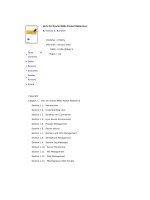Tài liệu DBA Handbook for Oracle P1 pdf
Bạn đang xem bản rút gọn của tài liệu. Xem và tải ngay bản đầy đủ của tài liệu tại đây (948.77 KB, 30 trang )
DBA
Hand Book
DBA Handbook
for Oracle
Technologies
SOLIX
®
Chapter 1: Introduction
Chapter 2: Oracle Database Architecture
2.1 The Database
2.2 The Instance
2.3 Database Components
2.4 Memory Structures
2.5 Oracle Processes for an Instance
Chapter 3: Administration Activities
3.1 Installing the Oracle Database Software
3.2 Creating Databases
3.3 Database Operation
3.4 Space Management
3.5 User Management
3.6 Oracle Network Management
Chapter 4: Managing Schema Objects
4.1 Tables
4.2 Clusters
4.3 Views
4.4 Indexes
4.5 Synonyms
4.6 Triggers
4.7 Database Links
Chapter 5: Database Security and User Management
5.1 Roles
5.2 Privilege
5.3 Grant
5.4 Revoke
5.5 Password Management
5.6 Oracle Auditing
Chapter 6: Database Tuning
6.1 Database Tuning Strategy
6.2 SQL Tuning
6.3 Memory Tuning
6.4 I/O Tuning
6.5 Sort Tuning
6.6 The Optimizer
6.7 SQL Explain Plan
5
6
7
7
8
20
23
26
27
29
30
34
37
38
43
44
47
48
49
52
53
54
55
56
58
59
60
61
63
66
67
68
70
71
71
72
73
Chapter 7: Backup and Recovery
7.1 Backup and Recovery Mechanisms
7.2 Expo
7.3 SQL*
7.4 Standby Database
Chapter 8: Data Dictionary and Built-In Packages
8.1 Useful Admin Tables
8.2 Useful V$ VIEWS :
8.3 Packages
Chapter 9: New Features in 9i and 10g
9.1 Version 9i. Enhancements
9.2 Improvements in Oracle Version 10g
Chapter 10: Database Monitoring
10.1 General Monitoring Scripts
10.2 Monitoring Memory Usage
10.3 Monitoring Disk I/O
10.4 Monitoring System Resources
10.5 Monitoring for Database Security
10.6 Monitoring Database Schema Objects
10.7 SQL Monitoring
10.8 Useful Unix Commands
Chapter 11: Archiving and Its Value to DBA
11.1 Introduction
11.2 What is driving the data growth?
11.3 Solution
11.4 Benefits
75
76
78
80
82
86
87
88
89
95
96
99
101
102
102
103
105
106
107
109
110
114
115
115
116
118
Preface:
Backed by a decade of expertise in Enterprise Applications Management, Solix
Technologies, Inc. is a leading innovator in providing data management solutions
to meet the demanding, high-availability, and high-performance requirements of
enterprise applications. Solix extends its experience in Oracle Database
Administration through this 'DBA Handbook'. This book intends to serve as a
definitive handbook for the installation, administration, and maintenance of
Oracle Database. It is focused on the administrative responsibilities and
techniques for database administrators using Oracle Database.
Oracle Technology:
The Oracle Relational Database Management System (RDBMS) is the most
popular relational database management system in use today. Organizations
ranging from government agencies to financial institutions have made use of the
Oracle RDBMS to maintain and process their data.
Why this book?
Oracle is a complex data processing environment encompassing hundreds of
software components and commands with more than 45 volumes of
comprehensive documentation. Several personnel performing a number of
specific design and administrative roles usually share administration of Oracle
RDBMS. As organizational needs and the number of users grow rapidly over
time, so does the complexity of the Oracle system. This book attempts to present
the user with easily accessible and concise information. It addresses many
technical challenges with the help of several illustrative examples. It is assumed
that the user has a basic understanding and familiarity of the Oracle Database
architecture. Several important concepts have been elaborated wherever
deemed appropriate.
Who should read this book?
This book is primarily targeted towards three categories of users:
Which Oracle Release does it apply to?
This book applies to Oracle 8i, Oracle 9i, and Oracle 10g. Some of the features
that are specific to Oracle 9i and Oracle 10g have been discussed in a separate
chapter, "New Features in release 9i and 10g."
Description
SOLIX Technologies (www.solix.com)
Database administrators who manage and maintain production Oracle
databases.
Oracle developers seeking to enhance their own database administration skills.
Junior database administrators trying to get to know the tricks of the trade.
2
Description
Resources:
Reach us at:
Solix Technologies, Inc.
685, West Maude Ave
Sunnyvale, CA 94085
Tel: +1-888-GO-SOLIX
Fax: +1-408-737-1607
Disclaimer:
This handbook contains references to brands and products of several
companies that are not owned by Solix Technologies, Inc. As such,
Solix, Inc. does not make any representations or evaluations in this
regard. All scripts and queries are guidelines and have to be further
customized according to your specific needs. Use them at your own risk.
3
SOLIX Technologies (www.solix.com)
· The Introduction
Introduction
Contents
CHAPTER
1
SOLIX Technologies (www.solix.com)
4
Chapter 1: Introduction
5
SOLIX Technologies (www.solix.com)
CHAPTER 1: INTRODUCTION
A database administrator in any company is responsible for establishing policies
and procedures pertaining to the management, security, maintenance and use of
database management systems. Besides planning, implementing and
maintaining databases for a company, they also play a key role in training users,
programmers and test engineers on database use and procedures. A Database
administrator's role requires knowledge in the following area:
Different computer platforms and operating systems existing
within an enterprise.
Database component and their interaction with each other.
Varied business rules defining the database system.
Swelling data growth issues and ever-changing business environment have left
DBA's with new challenges, different from their day-to-day tasks. It is imperative
that a DBA performs effectively and hence needs to constantly update his skills
and knowledge base. Moreover, A DBA has to foresee the need to deploy data
management solutions to ensure that the application environment continuously
provides the required level of performance. Some of these solutions have been
discussed towards the end of the book.
In a nutshell, this handbook is a complete guide to help improve a DBA's
performance in an Oracle Database environment.
Understand the business requirement for developing a database
system.
Plan resources (time and costs) needed to create database system.
Install Oracle Software.
Manage the database storage structures, schema objects, such as
tables and indexes.
Create and review troubleshooting procedures and plan for crisis
management.
Set up computer security procedures.
Monitor database growth.
Perform proactive monitoring and plan preventive maintenance.
Identify ways to measure and improve system performance.
Implement and maintain the primary and secondary storage devices for
production data and data backups respectively.
Upgrade Oracle Database and software to new release levels.
Database administrators spend a significant amount of time in maintenance and
management of the database. Installation and configuration of the database only
forms a small part of their day-to-day activities.
· The Database
· The Instance
· Database Components
· Tablespace
· The Control Files
· The Datafiles
· Initialization Parameters Files (init.ora)
· Server Parameter Files
· The Redo Log Files
· Trace and Alert Log Files
· Memory Structures
· System Global Area
· Program Global Areas
· Oracle Processes for An Instance
· Background Processes
Oracle Database Architecture
Contents
CHAPTER
2
6
SOLIX Technologies (www.solix.com)
Figure 1.Oracle Database
PARAMETER FILES CONTROL FILES
DATAFILES REDO LOG FILES
ORACLE DATABASE
Chapter 2: Oracle Database Architecture
7
SOLIX Technologies (www.solix.com)
CHAPTER 2: ORACLE DATABASE ARCHITECTURE
Overview
The Oracle Database is a repository of storable, updateable, and retrievable
data. The database itself is a collection of physical and logical structures
consisting of system, user, control, and datafiles. The files are collectively known
as the Oracle Database system. The Oracle Database server manages these
files.
2.1 The Database
The databases refer to the physical storage of data. Oracle Database System is
based on the relational database management model. The data is stored in two-
dimensional tables composed of columns and rows. The columns of an individual
table define the relational tables. Each of these columns defines a particular type
of data and is called an attribute. The data pertaining to an individual set of
records is stored in the rows. Individual tables can be related to each other.
These tables may even contain object-oriented structures such as abstract data
types and methods. All the data is stored in files and can be retrieved by using
database structures that provide the logical mapping of the data onto the files.
Different data types are stored individually in this manner.
2.2 The Instance
Instances refer to a particular set of software that is executed by the server. This
software provides access to the data stored in the database. The set of
processes that facilitate the storing, updating and retrieving the data along with
the memory on the database server form the Instance of the database. The
Instance has to be run on the same machine where the database is stored.
Instance acts as the interface that allows the users to communicate with the
server. The data flows between a user and the database only if the instance is
operational.
Figure 1.Oracle Instance.
SYSTEM GLOBAL AREA
PMON
CKPRT
SMON
REDO BUFFER STREAMS JAVA POOL
SHARED POOL LARGE POOL
BUFFER
CACHE
DBWR
ARCH
LGWR
Views Description
v$database Description of database parameter and status
Description of all active instances
Description of database files
Description of database links definitions and status
Description of status of all instances
Description of rollback information
Descriptions of undo information
Description of datafiles information
v$active_instances
v$dbfile
v$dblink
v$instance
v$rollstat
v$undostat
v$datafile
Chapter 2: Oracle Database Architecture
8
SOLIX Technologies (www.solix.com)
Related Views
2.3 Database Components
2.3.1 Tablespace
Tablespace is a logical structure belonging to a database system. Each database
has to have at least one tablespace called the system tablespace. Each
tablespace is made up of a collection of datafiles and can belong to only one
database.
ROLLBACK User Tablespace Index Tables
Temporary
Tablespace
System Aux
Tablespace
rbs 01
Dept Table
rbs 02
rbs 03
rbs 04
SYSTEM TABLE SPACE
SYSTEM ROLLBACK SEGMENT DATA DICTIONARY
Sales Table
Dept Index
Sales Index
Figure 3.Tablespaces.
Chapter 2: Oracle Database Architecture
9
SOLIX Technologies (www.solix.com)
To enable manual system tablespace management:
To create and manage the SYSTEM tablespace manually set the EXTENT
MANAGEMENT to LOCAL in the CREATE DATABASE statement. By default,
the database defines and manages the extent sizes and creates a dictionary-
managed SYSTEM tablespace.
Use the DBMS_SPACE_ADMIN package to migrate the dictionary-managed
SYSTEM tablespace.
SYSAUX Tablespace
The SYSAUX tablespace is defined during the creation of the database. It serves
as a default tablespace to many Oracle features and packages that were
previously assigned a separate tablespace. The size of SYSAUX tablespace
depends on the size of each individual component. The typical size of the
SYSAUX tablespace is about 250 MB at the time of creation of the database.
Default Permanent Tablespace
This tablespace is assigned to any non-system user for which an exclusive
permanent tablespace is not allocated. In case the Default Permanent
Tablespace is not defined, the non-system users are allocated space in the
SYSTEM tablespace.
The DB_CREATE_FILE_DEST, DB_CREATE_ONLINE_LOG_DEST_n, or
DB_RECOVERY_FILE_DEST parameters in the initialization parameter file have
to be initialized to create and manage the operating system files belonging to the
database initialize.
All copies of the control files pertaining to a particular database are
permanently damaged.
Some of the permanent parameters of the database such as the name of
the database, etc. have to be changed. (The RESETLOGS clause
must be specified in case the database has to be renamed.)
· SQL>ALTER DATABASE BACKUP CONTROL FILE TO TRACE
· SQL>STARTUP NOMOUNT
Chapter 2: Oracle Database Architecture
10
Views Description
v$database Description of the control file
Displays the list of control file names
Description of control file record
Displays the names of the control files that are
stored in the initialization parameter file
v$control files
v$control file record section
v$parameter
SOLIX Technologies (www.solix.com)
2.3.2 The Control Files
The control files contain information about the contents and the state of
the database. The location of important files such as datafiles, redo log
files, and administrative information such as the database name, date
and time of creation, current state, and list of backups performed, is
stored here. If the administrator has enabled Oracle managed files, the
control file is created as the Oracle managed control files. Always have a
backup of the control file.
Related Views
New Control File
A new control file is created if:
To create a new control file:
1. Collect all the information related to datafiles and the redo files by running
the following queries.
2. Shut down the database.
3. Make a backup of all the datafiles that belong to the database by copying
the files to a different location.
4. Start a new instance without mounting the database.
SQL> CREATE CONTROLFILE
SET DATABASE slx_db01
LOGFILE GROUP 1
('/mnt/sdc1/1159/slx_db01/redo01_01.log',
'/mnt/sdc1/1159//slx_db01/redo01_02.log'),
GROUP 2
('/mnt/sdc1/1159/slx_db01/redo02_01.log',
/mnt/sdc1/1159/slx_db01/redo02_02.log'),
GROUP 3
('/mnt/sdc1/1159/slx_db01/redo03_01.log',
'/mnt/sdc1/1159/slx_db01/redo03_02.log')
RESETLOGS
DATAFILE '/mnt/sdc1/1159//slx_db01/system01.dbf'
SIZE 3M,
'/mnt/sdc1/1159/slx_db01/rbs01.dbs'
SIZE 5M,
'/mnt/sdc1/1159/slx_db01/users01.dbs'
SIZE 5M,
'/mnt/sdc1/1159/slx_db01/temp01.dbs'
SIZE 5M
MAXLOGFILES 50
MAXLOGMEMBERS 3
MAXLOGHISTORY 400
MAXDATAFILES 200
MAXINSTANCES 6
ARCHIVELOG;
Views Description
MAXLOGFILES
MAXLOGMEMBERS
MAXLOGHISTORY
MAXDATAFILES
MAXINSTANCES
The maximum number of redo log files that the database
can have is specified by this parameter
The maximum number of members that belong to each
redo log file group is specified by this parameter
The maximum number of history files that each control
file can contain is specified by this parameter. The
history files facilitate the automatic recovery of the
database
The number of datafiles that the control file can keep
track of is specified by this parameter. In case more
datafiles are added to the database, the control file will
account for it automatically
The number of instances that the control file can track
is specified by this parameter. This parameter is
applicable to the RAC architecture
Chapter 2: Oracle Database Architecture
11
SOLIX Technologies (www.solix.com)
5. Create a new control file as shown using CREATE CONTROLFILE.
Important Control File Parameters
SQL>SELECT NAME FROM v$controlfile;
CONTROL_FILES = (
/mnt/sdc1/1159/slx_db01/slx_db01ctl1.ctl,
/mnt/sdc1/1159/slx_db01/slx_db01ctl2.ctl,
/mnt/sdc1/1159/slx_db01/slx_db01ctl3.ctl).
If the database has to be renamed, edit the DB_NAME
in the initialization parameter file and restart the
database by specifying the USING BACKUP CONTROL FILE
clause.
Once the database is opened using the new control file,
check the alert file for any inconsistencies between the
data dictionary and the control files.
In case any datafiles present in the data dictionary
are not included in the control file, filename
MISSINGnnn appears in the control file and is interpreted
by Oracle as files needing recovery or being offline.
In case the user does not include a filename or adds a
new filename while creating the control file, Oracle
issues error such as ORA-01173, ORA-01176, ORA-01177,
ORA-01215, or ORA-01216, while mounting the database.
Chapter 2: Oracle Database Architecture
12
SOLIX Technologies (www.solix.com)
To enable multiple copies of control file the init.ora file should include the
following:
To create additional copies of the control file:
1. Shutdown the database.
2. Copy the existing control file to a new location.
3. Edit CONTROL_FILE parameter in the init.ora.
4. Restart the database.
To list all control files:
The CONTROL_FILES initialization parameter has to be edited so that it points
to the new control file:
To backup a control file:
The control file can be backed up as a binary file.
ALTER DATABASE BACKUP CONTROLFILE TO
'(/mnt/sdc1/1159/slx_db01/backup/control.bkp';
To backup a control file as a text file:
ALTER DATABASE BACKUP CONTROLFILE TO TRACE;
- Shut down the instance.
- Copy new files from backup files.
- Restart the instance.
- Edit init.ora, remove the entry corresponding to the control file.
- Shut down the database.
- Start up the database.
ALTER DATABASE BACKUP CONTROLFILE TO TRACE;
1. Shut down the database.
2. Copy the control file to the new location.
3. Edit the CONTROL_FILES parameter in the
initialization parameter file to point it towards
a new location.
4. Restart the database.
Chapter 2: Oracle Database Architecture
13
Views Description
dba_data_files Description of the database data file
SOLIX Technologies (www.solix.com)
To backup a control file as a text file:
To recover a control file:
To drop a control file:
To relocate the control file:
2.3.3 The Datafiles
The datafiles hold data pertaining to the tables, the data dictionaries, and the
rollback segments. Each Oracle Database has more than one physical datafile
associated with it. A single datafile can be associated with only one database.
The datafiles can be set to dynamically increase in size, if required. A collection
of datafiles belonging to one logical unit is called tablespace.
Related Views
There is always a sample initialization parameter file
provided by Oracle's Database Configuration Assistant.
This file can be used directly or can be customized. In
case a parameter is not defined in the initial-
-ization file, Oracle proceeds with the default values.
Use the ALTER SYSTEM statement after the database has
been created to alter the initialization.
ALTER TABLESPACE slx_tbs_01
ADD DATAFILE 'slx_df04.dbf'
SIZE 100K
AUTOEXTEND ON
NEXT 10K
MAXSIZE 100K;
ALTER DATABASE
DATAFILE
'/mnt/sdc1/1159/slx_db01/slx_dbf01.dat'
RESIZE 20 M;
ALTER DATABASE
RECOVER STANDBY DATAFILE
'/mnt/sdc1/1159/slx_db01/slx_stbs01.f'
UNTIL CONTROLFILE;.
Chapter 2: Oracle Database Architecture
14
SOLIX Technologies (www.solix.com)
To add a datafile:
To resize a datafile:
To recover a standby datafile:
The following statement recovers the standby datafiles including all the relevant
archived logs and current standby database control file.
2.3.4 Initialization Parameters Files (init.ora)
The characteristics of the Oracle Database can be defined by setting initialization
parameters. The init.ora file stores these parameters and is referred to by the
Oracle system before mounting the database.
CONTROL_FILES =
(/mnt/sdc1/1159/slx_db01/slx_db01ctl.001.dbf,
/mnt/sdc1/1159/slx_db01/slx_db01ctl1.002.dbf,
(/mnt/sdc1/1159/slx_db01/slx_db01ctl1.003.dbf,)
DB_NAME = slx_db01DB_
DOMAIN = slx.com
LOG_ARCHIVE_DEST_1 =
"LOCATION(/mnt/sdc1/1159/slx_db01/arch"
LOG_ARCHIVE_DEST_STATE_1 = enable
DB_BLOCK_SIZE = 8192
PGA_AGGREGATE_TARGET = 2500M
PROCESSES = 900
SESSIONS = 1200
OPEN_CURSORS = 1024
UNDO_MANAGEMENT = AUTO
SHARED_SERVERS = 2
REMOTE_LISTENER = tnsslx_lcg03
UNDO_TABLESPACE = slx_und01
COMPATIBLE = 10.1.0.0.0
NLS_LANGUAGE = AMERICAN
NLS_TERRITORY = AMERICA
DB_RECOVERY_FILE_DEST_SIZE = 60G
- Global Database Name
- Flash Recovery Area
- Control Files
- Database Block Sizes
- System Global Area
- Maximum Number of Processes
- Undo Space Management
- Compatibility of Initialization Parameter
- License Parameter
DB_NAME cannot contain more than eight characters and
must be a text string.
The DB_NAME is recorded in the datafiles, control files,
and the redo files during the database creation.
The database will not start if the database
name in the control file does not match with the
DB_NAME parameter.
Chapter 2: Oracle Database Architecture
15
SOLIX Technologies (www.solix.com)
Sample init.ora file
Important Initialization parameters include:
Global Database Name
The global database name is a concatenation of the individual database name
and the domain name.
· DB_RECOVERY_FILE_DEST specifies the destination of
the files.
· DB_RECOVERY_FILE_DEST_SIZE specifies the maximum
bytes that the flash recovery area can use.
Once the block size is set, it is used by the SYSTEM
tablespace. If the parameter is not set, the default is
obtained by the operating system. This parameter cannot
be changed after the creation of the database.
A larger data block results in more efficient performance
of Oracle in a data warehouse.
Chapter 2: Oracle Database Architecture
16
SOLIX Technologies (www.solix.com)
Flash Recovery Area
The database stores all the files related to backup and recovery in the flash
recovery area. This area is separate from the database area where Oracle stores
datafiles, redo logs, and the control files. This feature is specific to Oracle 10g.
The two main parameters associated with the definition of the flash recovery
area are:
Control Files
The database can be associated with more than one control file. This is specified
using the CONTROL_FILES initialization parameter. As the CREATE
DATABASE statement is executed the control files specified by the
CONTROL_FILES parameter are created.
Database Block Size
The standard block size for the entire database can be specified using the
DB_BLOCK_SIZE.
System Global Area
System global area is made up of different pools of memory. These pools of
memory are used to meet the memory allocation requests.
Maximum Number of Processes
The maximum number of processes that can be concurrently connected to the
database is determined by the PROCESSES parameter. The lowest value
assigned to this parameter is one. The number of processes mainly depends on
the feature being used.
Undo Space Management
The undo space is used to store the rollback or undo changes that were made to
the database before they are committed. These records are called undo records.
To start the automatic undo management mode, set the UNDO_MANAGEMENT
parameter in the initialization parameter to AUTO.
In case the initialization parameter text file is used
to alter the parameters, only the values for the current
instance are altered.
Altering the server parameter file would make the initia-
-lization file persistent. Use the SET clause with the
ALTER SYSTEM statement to the initialization parameters
in the server parameter file.
When SCOPE = SPFILE, the changes to the dynamic
parameters are effective at the next STARTUP.
When SCOPE = MEMORY, the new dynamic parameters are
effective immediately but not persistent.
When SCOPE = BOTH, the new dynamic parameters are
effective immediately and remain persistent.
LICENSE_MAX_USERS = 250
SQL> ALTER SYSTEM SET init_parameter = '';
SQL> CREATE PFILE='/mnt/sdc1/1159/slx_init.ora'
FROM SPFILE='/mnt/sdc1/1159/slx_spfile.ora';
Oracle creates a default name that is platform specific
in case the name of the new parameter file is not
specified.
Chapter 2: Oracle Database Architecture
17
SOLIX Technologies (www.solix.com)
Compatible Initialization Parameter
Every version of Oracle uses a number of features that are based on the file
system format. All the files relevant to these features can be used by different
versions of Oracle by setting the appropriate COMPATIBLE initialization
parameter.
The License Parameter
This parameter enforces named user licensing. The maximum number of users
that can be created can be specified. New users cannot be created once the
maximum number of users is reached.
To alter the initialization parameter values:
Note: The initialization parameter can be edited using the ALTER SYSTEM
statement.
To reset the initialization parameter:
The initialization parameters are restored to the default value by using the empty
string. In case of Boolean parameters, the value has to be stated explicitly.
To Create initialization text file from the server parameter files:
SQL> CREATE SPFILE=
'/mnt/sdc1/1159/slx_db01/spfileslx_db1.ora'
FROM PFILE=
'/mnt/sdc1/1159/slx_db01/admin/initslx_db01/scripts/init.ora';
A new server parameter file is created.
The new server parameter file will overwrite any existing
file.
In case no name is supplied then Oracle gives a default
name spfile$ORACLE_SID.ora.
If the server parameter file is created in any location
other than the default location, the parameter file has
to contain the following line.
SPFILE = '/mnt/sdc1/1159/slx_db01/'
Chapter 2: Oracle Database Architecture
18
SOLIX Technologies (www.solix.com)
2.3.5 Server Parameter Files
The initialization parameters are stored in a binary server parameter file. This file
is persistent over the database startup and shutdown. The changes that are
made in the initialization file, even when the instance is running, are persistent
during startup and shutdown.
The actual parameter file is created using the SPFILE statement. Once the
STARTUP command is issued, the initialization parameters are read from the
server parameter file. To use the text initialization parameter file at startup, use
the PFILE clause during the STARTUP command.
To deploy Server Parameter File during the startup instead of the
initialization parameter file:
- Place the file on the server machine.
- Create the server parameter file using CREATE SPFILE statement before
the STARTUP command is issued.
- Log in as SYSDBA or SYSOPER.
- SHUTDOWN the database.
2.3.6 The Redo Log Files
Every database is associated with two or more redo log files collectively called
redo log. Commit results in the updating of the redo log files. The datafiles are
updated asynchronously. The redo-log records all changes made to the data. If
the database fails before the data in the datafiles is modified, the changes are
lost. These changes can be obtained from the redo log files. Multiple copies of
the log files are maintained in order to protect against failure of the redo log file.
If the database has to be renamed, edit the DB_NAME
in the initialization parameter file and restart the
database by specifying the USING BACKUP CONTROL FILE
clause.
SQL> ALTER DATABASE
ADD LOGFILE GROUP 3
('/mnt/sdc1/1159/slx_db01/redo_log3.log',
'/mnt/sdc1/1159/slx_db01/redo_log4.log') SIZE 50K;
SQL> ALTER DATABASEADD LOGFILE MEMBER
'/mnt/sdc1/1159/slx_db01/redo_log3.log'TO GROUP 3
SQL> ALTER DATABASE
CLEAR LOGFILE '/mnt/sdc1/1159/slx_db01/redo_log4.log';
SQL> ALTER DATABASE DROP LOGFILE group 4;
SQL> ALTER DATABASE RENAME FILE
'/mnt/sdc1/1159/slx_db01/redo_log4.log' TO
'/mnt/sdc1/1159/slx_db01/redo_log5.log';
SQL> ALTER DATABASE
DROP LOGFILE MEMBER
''/mnt/sdc1/1159/slx_db01/redo_log3.log/log3.log'
Chapter 2: Oracle Database Architecture
19
SOLIX Technologies (www.solix.com)
To add a redo file:
To add a redo log file group:
To rename a redo log file member:
To clear log file:
To drop a redo file:
To drop the entire group:
2.3.7 Alert Log Files
Oracle records all major events such as the startup status, shutdown status,
addition of tablespaces, etc. corresponding to the database. This information is
stored in the alert log files.
2.3.8 Auto Trace Files
The server dumps some information into the trace files in case there is an error
while running the background processes. Most of this information can be used to
troubleshoot any issue with the database. The Oracle support team uses this
information to debug.
2.3.9 User-generated Trace Files
The user to diagnose performance issues can track specific events. Making use
of the ENABLE TRACE option before performing any specific action will do this
SQL> SHOW PARAMETER user_dump_dest;
JAVA POOL
STREAMS LARGE POOL
Handles all java methods
and classes
Memory controlled by
Java-pool-size parameters
SYSTEM GLOBAL AREA (SGA)
Controls stream activity
Streams-pool-size parameters
control the memory region
Hold items for shared
server operations and
back up
Large-pool-size parameters
control the memory region
SHARED POOL
BUFFER CACHE REDO BUFFER
Holds the object structures
code definitions and other
meta data
Memory region controlled by
Shared-pool-size parameters
Default memory cache that
shares data blocks when
read from DB
Memory area controlled by
db-block-buffers parameter
and db-cache-size parameters
Buffer modifications that
are made to the database
before they are physically
written into the redo log files
Log-buffer configuration
parameter controls the
mermory area
Figure 4. System Global Area
Views Description
v$sga SGA status
SGA components status
Tablespace definition and configuration
Description of cache information
Status of the library cache
Status of cache used by each object
v$sga_stat
v$tablespace
v$cache
v$librarycache
v$db_object_cache
Chapter 2: Oracle Database Architecture
20
SOLIX Technologies (www.solix.com)
To return the path of the trace files:
2.4 Memory Structures
Oracle uses memory to store the program code, connected sessions, and
information about various executing processes, data blocks, and redo logs. The
memory structure is classified as system global area and program global area.
All the processes share the system global area. The program global area is
private to each server process.
Related Views
SHARED_POOL_SIZE=128M
DB_CACHE_SIZE=896M
DB_BLOCK_SIZE=4096
DB_CACHE_SIZE=1024M
DB_2K_CACHE_SIZE
DB_4K_CACHE_SIZE
DB_8K_CACHE_SIZE
DB_16K_CACHE_SIZE
DB_32K_CACHE_SIZE
Chapter 2: Oracle Database Architecture
21
SOLIX Technologies (www.solix.com)
2.4.1 System Global Area
The SGA is a portion of memory containing the data and the control information
that belongs to each Oracle Database Instance. The data present here is shared
among all the users that are connected to the same instance.
Various SGA components allocate and de-allocate units of memory as and when
there are requests for memory allocation from the processes. The units of
memory are called granules. The size of these granules depends on the size of
the entire SGA. Typically an SGA of 1GB has granules of 4 MB in size, and an
SGA larger than 1 GB has granules 16 MB in size.
The size of the SGA can be limited using the SGA_MAX_SIZE parameter. In
case it is not specified, Oracle assigns a specific value to SGA_MAX_SIZE
based on the sum of the sizes of all the components.
Setting Maximum Memory Manually
Database Buffer Cache
The database buffer cache holds copies of data blocks that are retrieved from the
datafiles. The database buffer is logically divided into two portions: the Write list
and the Least Recently Used (LRU) list.
To set the database buffer cache size manually:
To set non-standard block sizes for multiple block sizes:
Redo Log Buffers
All changes that are made to the database including INSERT, DELETE,
UPDATE, ALTER, CREATE, and DROP are saved in the redo log buffers. Redo
entries from these buffers are used if the database crashes. The LGWR process
writes the redo log buffers into the redo log files.
External controls are provided in order to dynamically
increase or decrease the use of the physical memory.
The SGA growth is based on the maximum value set for the
parameter SGA_MAX_SIZE.
Oracle managed policies specify the buffer cache and the
SGA individual pools sizes.
The memory can be locked on to the SGA by using the
LOCK_SGA parameter.
SGA starting address can be specified by setting.
SHARED_MEMORY_ADDRESS and HI_SHARED_MEMORY_ADDRESS parameters.
Chapter 2: Oracle Database Architecture
22
SOLIX Technologies (www.solix.com)
Shared Pool
The shared pool contains the dictionary and the library cache, control structures,
and parallel execution buffers. The size of the shared pool can be set by the
SHARED_POOL_SIZE initialization parameter and is typically 8 MB or 64 MB.
SQL Pool Area
The SQL statements issued by the user are parsed and executed in this memory
area. The memory for this portion is allocated dynamically depending on the
complexity of the statement. Multiple users running the same program share the
same memory area. The specific values pertaining to the session are stored in
the private area of the user.
Java Pool
The java code specific to the session is stored in this portion of memory. The
information about the library cache memory used for java can be viewed using
the java pool advisor statistics. Setting STATICS_LEVEL to TYPICAL or higher
enables the java pool advisor.
Large Pool
A portion of the memory can be programmed to serve as session memory for all
the shared servers that perform transactions requiring them to interact with more
than one database. All I/O, backup, and restore processes use this pool of
memory.
Stream Pool
The SGA memory is used by the streams allocated from this pool, if the
STREAMS_POOL_SIZE is set greater than zero. In case this parameter is set to
zero, a portion of the shared pool is allocated to the streams.
Data Dictionary Cache
The Data dictionary is a collection of a set of data tables and views that holds the
referential information about the database, its structures, and its users. Two
locations hold the data dictionary: the data dictionary cache and the row cache.
All user processes share these two areas.
The total size of memory dedicated towards the PGA can be
set using the initialization parameter
PGA_AGGREGATE_TARGET.
The memory management for the PGA set to automatic by
setting the parameter WORKAREA_SIZE_POLICY to AUTO.
- Private SQL area
- Cursor area
- Session memory
Views Description
v$sysstat Lists all the available statistics
Session statistics
PGA Memory status
v$sesstat
v$pgastat
SQL> SELECT pga_used_mem, pga_allocated_mem,
pga_max_mem FROM v$process;
Chapter 2: Oracle Database Architecture
23
SOLIX Technologies (www.solix.com)
2.4.2 Program Global Areas
The data and control information of a particular server process is assigned to a
portion of the program global area. Other process and servers do not share this
memory space. This memory space is accessed only by Oracle. The
accumulation of the memory allocated to each server process belonging to an
instance is called aggregated PGA.
The PGA consists of:
Managing the PGA
Related Views
To find the PGA memory utilization
2.5 Oracle Processes for An Instance
A process can be defined as a 'thread of control' that executes a series of
instructions. Each process is associated with a private memory space in which it
is executed. Oracle supports multiprocessing, enabling several users and
applications to run different parts of the Oracle code without compromising the
performance of other systems.
The database processes can classified into dedicated server processes and
shared server processes. The database allows all dedicated server processes to
be processed by default. The shared server processes have to be set up by
configuring initialization parameters.









